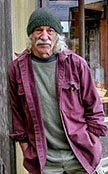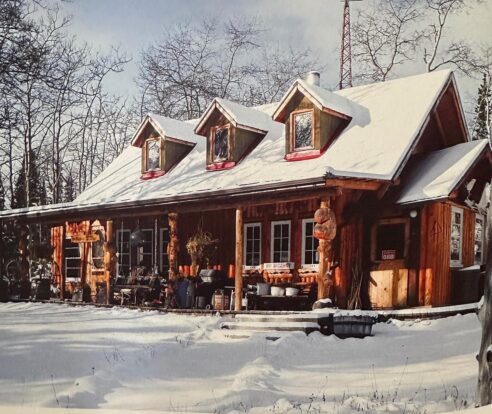First, turn off the intrusive sound track.
By Chiara Fiorillo News Reporter
16 Sep 2023
A hermit may have lived in a precarious house perched on the side of a cliff in California for the past 10 years — but nobody seems to know who the man actually is.
A dilapidated three-storey structure, made of driftwood, was first spotted at Devil’s Slide in the San Francisco Bay Area in December 2022, when it was filmed by a drone. Stunned onlookers said the intriguing home was partially destroyed during the rainstorms that hit the Bay Area earlier this year but has since been rebuilt.
Drone operator @ParallaxEffect, who posted footage of the driftwood shack on YouTube, said he was hiking along the California coast with some friends when they noticed the property, which he described as “one of the most incredible human structures I’ve ever seen”.
The shack appears to have several rooms and is located on the steep San Mateo County rock face. The video shows wood and ropes in the structure as well as a boxing punching bag, several buoys, some old signs, and what appears to be a fully enclosed room.
On Google Earth, the shack appears to have a rope rising from it, which is linked to the Devil’s Slide trail above — and it may possibly be used as a means of entry and exit. A Google Maps satellite image also seems to show the structure intact as waves crash onto the rocks beneath it.
www.mirror.co.uk/news/us-news/mystery-hermit-living-cliffside-shack-30955761



If you look at the left, there appears to be a cave or tunnel. When blown up, there appears to be a pathway of rocks leading into it.???
In my years of photographing driftwood shacks for the book: Driftwood Shacks: Anonymous Architecture Along the California Coast, I never saw anything faintly resembling this.
Wow!!
Thanks to Jeff Sinder and Ruth Kneass
Tags: adventures, architecture, California, camping, design, driftwood shacks, exploring, natural building, natural materials, recycling, tiny houses, tinyhome, tinyhouse www.Romania.org
From Trish Green
257781

Photo by Nin Solis – Living Inside
Article by Anna Bisazza
Deep in the Mexican countryside of Valle de Bravo — a lush escape about two hours’ drive from Mexico City — Emiliano Garcia and Helene Carlo found the perfect spot to build an eco home. Partners in life and in ASPJ, a Mexican architecture and landscape design studio, the couple had a burning question: can we build more sustainably and cheaper, and in a way that can be widely copied?
The main structural element is a concrete cube that supports the rest of the house.
“It was important for us to prove its feasibility and to be able to make our structure replicable, not only a one-of-a-kind,” says Garcia. The couple are keen for this type of building to become the rule rather than the exception.
La Lomita is named for its hilltop position, from where it looks out on to the picturesque surrounding mountains from its secluded spot, and is accessed by a small dirt road. The structure is distinguished by an unusual single arched roof and an open facade with corrugated metal finishing that loosely evokes the image of an aircraft hangar, but there are many other experimental features meticulously planned by Garcia and Carlo that are not immediately obvious.
“Being able to take weight off the building, bringing it to half of what it would normally be in a conventional build, was a really successful outcome,” says Garcia. The main structural element is a concrete cube that encloses two bathrooms and the staircase. It supports the rest of the house, which is built primarily in wood. “This means we’re not intervening heavily in the foundation by digging deep into the ground and building concrete slab layers. Here, we managed to separate the house from the ground, only attaching it to the necessary structural points.”
A second critical aspect for Garcia and Carlo was the traceability of materials and controlling as much as possible their impact on the environment. To build the columns, floors and walls — which amounts to 70% of the house — they used recycled laminated wood made from boxes for the transport of car parts in Volkswagen and Audi factories. “This is FSC-certified wood from Europe and we’re giving it a second use as OSB [oriented strand board], a material that is gaining popularity these days.”
www.theguardian.com/lifeandstyle/2023/jun/25/ready-to-soar-inside-a-dramatic-eco-home-in-mexico
Formosa 1140, a condominium building in Los Angeles designed by Lorcan O’Herlihy Architects, sits next to a public green space that was created out of part of its lot.
Article in New York Times on multi-family housing, May 5, 2023, by Julie Lasky

On Saturday Lesley and I were in Union Square in San Francisco and did a little sightseeing. We went into the Neiman-Marcus store, a new and architecturally disastrous building that replaced the beloved City of Paris building (yes, they preserved the atrium, but the sleek glass and metal skin around the rotunda, as architectural Paul Goldberg wrote in the NYT, is “…one of this city’s most conspicuous architectural mistakes.”)
MOREOVER, check out the prices ($790 for a pair of sneakers, $5300 for that pair of long black boots)!
Almost all the items (especially the purses and handbags) in there looked ugly to my unsophisticated country boy eyes. Well, wait a minute, here’s a nice shirt, but, ulp, $1650.
What kind of people buy krap at such outrageous prices?
Go to my Instagram post to see the 40-odd comments.
257568
This is one the best building books I’ve ever seen. These cabins are tuned in, just right. I’ll bet they are all designed and built by builders — refreshingly, not by architects.
Photos are elegant, layout outstanding.
Everything is just right.
At this time only available from publisher in Canada. (I’m encouraging Finella to get it more widely distributed.}
I totally recommend this book.
(I apologize for my photos of the pages, shot on iPhone, not greatest quality of reproduction.)
www.cabinsoftheyukon.com
257546
Tags: builders, building, carpentry, crafts, design, natural materials, natural world, off-the-grid, tiny homes, tiny houses, tinyhome, tinyhouse, woodwork Hi Lloyd,
This photo shows the structure of St. Mary of the Angels Catholic Church in Wellington, New Zealand. The church is around 100 years old and is an early attempt at building in a Gothic style with concrete. The stained glass windows were imported by ship from Munich, Germany from a factory later destroyed in World War Two.
Kind regards,
Bill (Choquette)

The Red Rockers’ 60-foot dome in Colorado, built from math in Domebook One. Jack Fulton and I dropped in on them unannounced on a snowy Saturday night in 1972 when we were on a trip shooting photos for Shelter (published in 1973). We lucked into a venison dinner and then a rock-and-roll band in a small nearby town.
The Rockers had moved to Colorado from LA and built the communal dome.
But as time passed, couples wanted more privacy and began building little outlying sheds.
257440

































